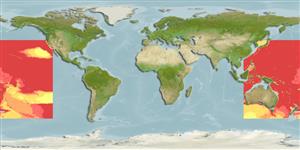>
Myctophiformes (Lanternfishes) >
Myctophidae (Lanternfishes) > Myctophinae
Etymology: Myctophum: Greek, mykter, -eros = nose + Greek, ophis = serpent (Ref. 45335).
More on author: Garman.
Environment: milieu / climate zone / depth range / distribution range
Ecologia
marinhas batipelágico; oceanódromo (Ref. 51243); intervalo de profundidade 412 - 1537 m (Ref. 27311). Deep-water; 42°N - 52°S, 112°E - 117°W
Circumglobal (Ref. 7300) in all tropical and subtropical waters (Ref. 47377). Eastern Atlantic: Morocco to South Africa (as expatriates in Agulhas water pockets). Western Atlantic: between about 42°N and 34°S. Indian Ocean: between 7°N and 24°S. Pacific Ocean: between 32°N and 31°S, but extends northward to 40°N in the Kuroshio Current. South China Sea (Ref.74511).
Comprimento de primeira maturação / Tamanho / Peso / Idade
Maturity: Lm ?, range 6 - ? cm
Max length : 8.3 cm SL macho/indeterminado; (Ref. 4479)
Espinhos dorsais (total) : 0; Raios dorsais (total) : 12 - 14; Espinhos anais: 0; Raios anais : 18 - 21; Vértebras: 36 - 39. Branchiostegal rays: 9-10 (Ref. 31442). Anal organs 14; male supracaudal gland has 5-8, female infracaudal gland with 2-6 small, round to oblong spots, respectively; may be distinguished from all other Myctophum possessing cycloid scales by its angulate, non-serrate, posterodorsal margin of the operculum (Ref. 39633).
High-oceanic, nyctoepipelagic at the surface and to 950 m and generally found between 475-850 m during the day (Ref. 4479). Neustonic to mesopelagic (Ref. 58302). Oviparous, with planktonic eggs and larvae (Ref. 31442). Lipid content is 3.8 % in fresh body weight and wax ester is 10.6 % in total lipids (Ref. 9193). Females reach sexual maturity at 4.8 cm, males at 3.5 cm (Ref. 47377).
Hulley, P.A., 1990. Myctophidae. p. 398-467. In J.C. Quero, J.C. Hureau, C. Karrer, A. Post and L. Saldanha (eds.) Check-list of the fishes of the eastern tropical Atlantic (CLOFETA). JNICT, Lisbon; SEI; Paris; and UNESCO, Paris. Vol. 1. (Ref. 4479)
Status na Lista Vermelha da UICN (Ref. 130435)
Ameaça para os humanos
Harmless
Uso pelos humanos
Ferramentas
Relatórios especiais
Baixar XML
Fontes da internet
Estimates based on models
Preferred temperature (Ref.
123201): 4.2 - 8.7, mean 6.2 °C (based on 536 cells).
Índice de diversidade filogenética (Ref.
82804): PD
50 = 0.5000 [Uniqueness, from 0.5 = low to 2.0 = high].
Bayesian length-weight: a=0.00912 (0.00476 - 0.01747), b=3.12 (2.95 - 3.29), in cm total length, based on LWR estimates for this species & (Sub)family-body (Ref.
93245).
Nível Trófico (Ref.
69278): 3.4 ±0.45 se; based on food items.
Generation time: 2.6 ( na - na) years. Estimated as median ln(3)/K based on 1
growth studies.
Resiliência (Ref.
120179): médio(a), tempo mínimo de duplicação da população 1,4 - 4,4 anos (K=0.42; tm=3).
Fishing Vulnerability (Ref.
59153): Low to moderate vulnerability (28 of 100).
